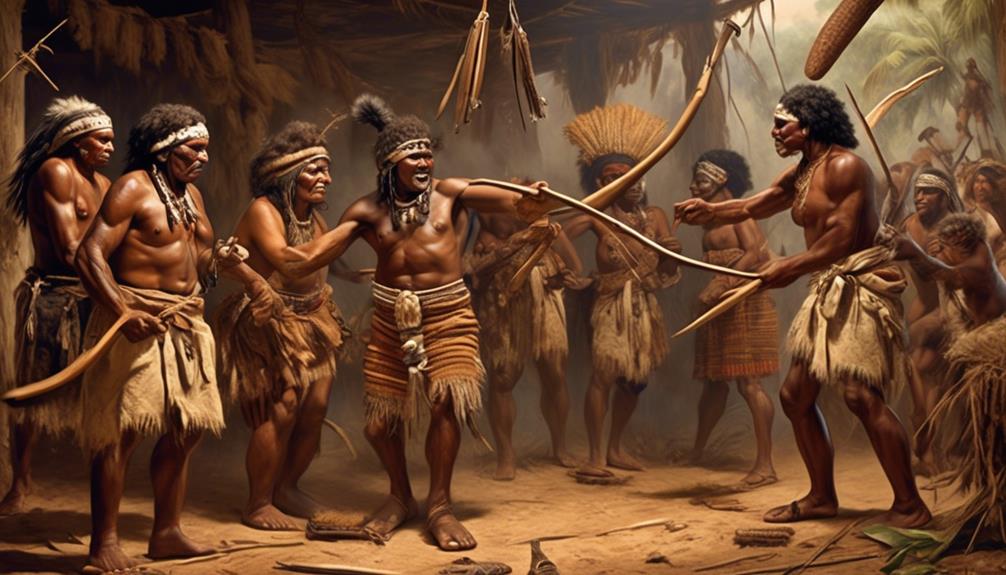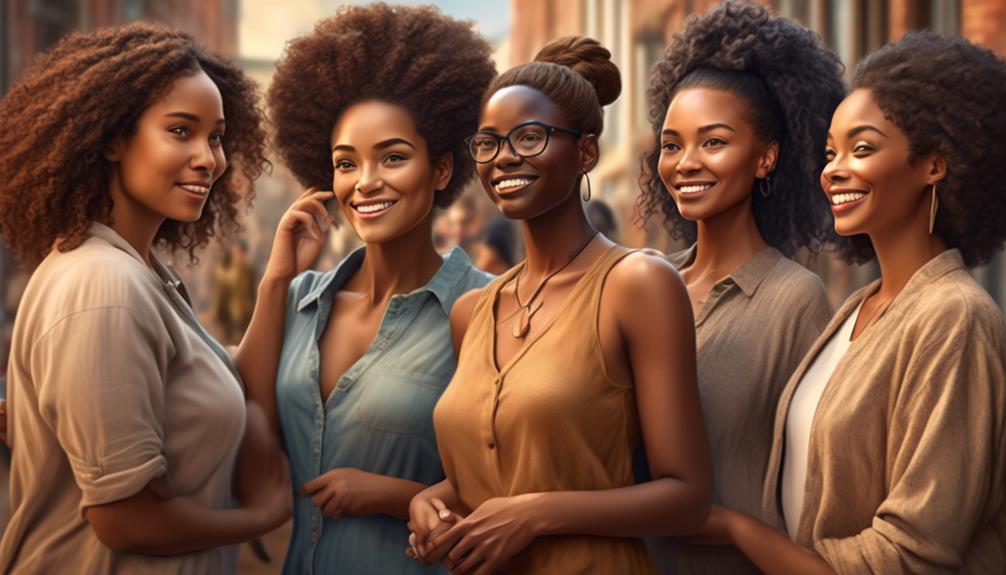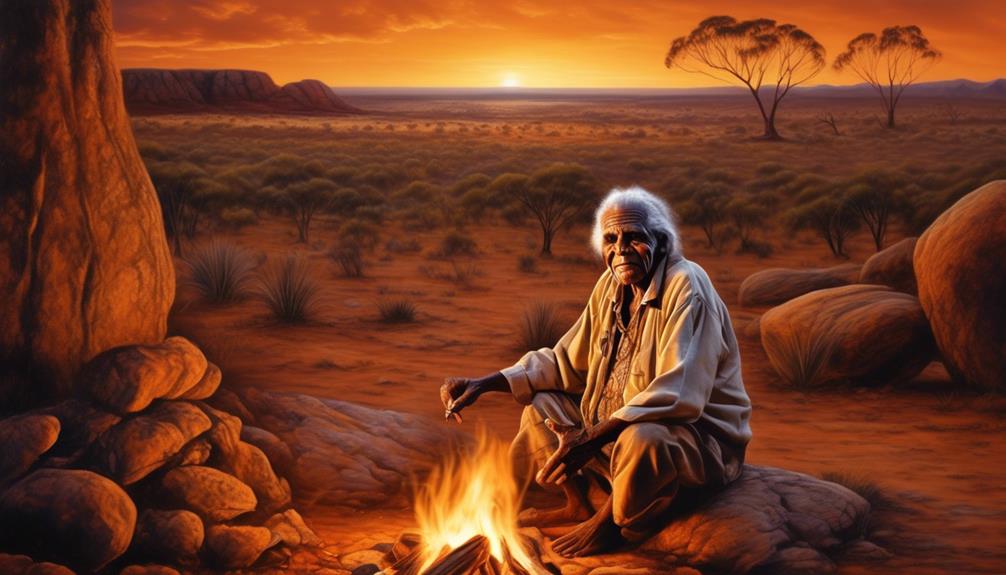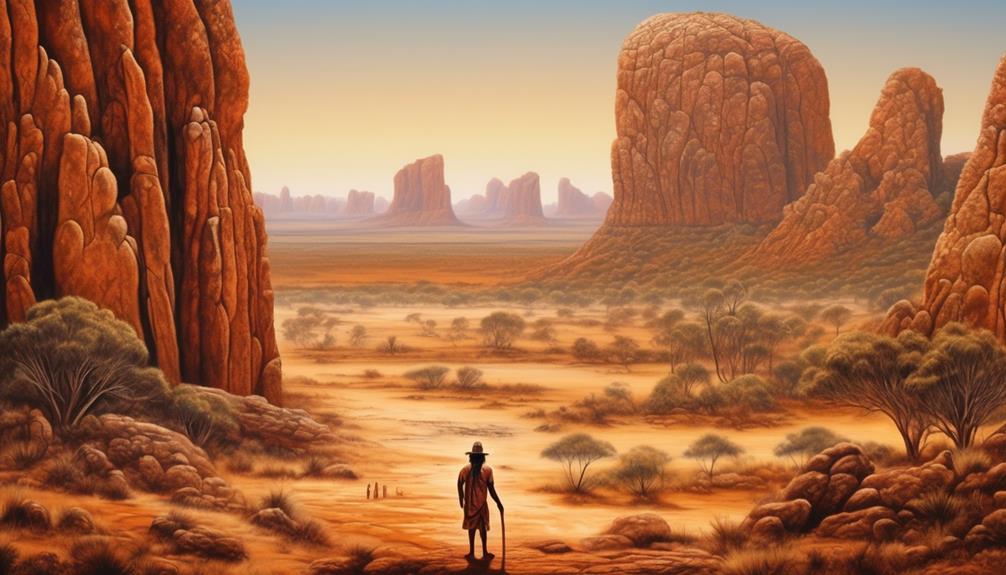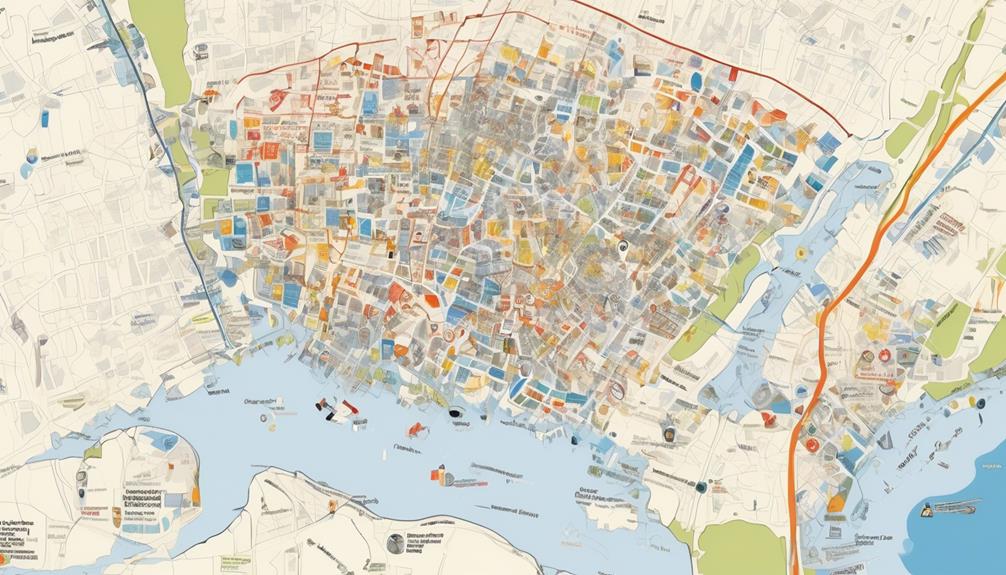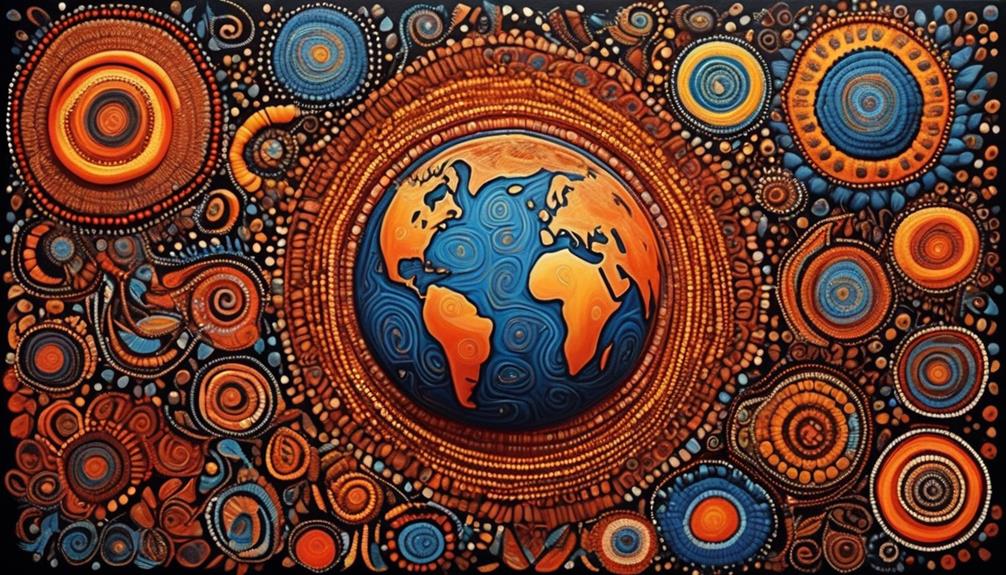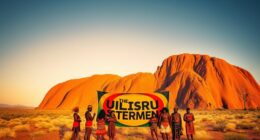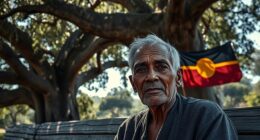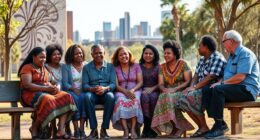When thinking about the Australian coast during the British colonization era, it is interesting to consider the trade relationships between the Aboriginal Australians and the incoming colonizers.
The cultural intersection between these two groups sparked a significant exchange of traditional Indigenous items and imported British goods, leading to a complex web of trade and adaptation.
But what exactly were the items that passed between these two worlds, and how did this exchange impact the societies involved?
The answers to these questions reveal a fascinating chapter in history that sheds light on the resilience and adaptability of Aboriginal cultures in the face of immense change.
Key Takeaways
- Indigenous Australians had a sophisticated system of trade in place before the arrival of British colonizers, showcasing their deep knowledge of the environment and resources.
- The trading of goods played a crucial role in shaping early relationships between Indigenous Australians and British colonizers.
- British colonizers introduced new items such as textiles, metal tools, weapons, and ceramics to Indigenous communities, which revolutionized traditional practices and influenced the understanding of the land and its resources.
- The exchange of goods and knowledge between Indigenous Australians and British colonizers facilitated a process of cultural adaptation and transformation, resulting in the sharing of agricultural techniques, food, language, and social customs.
Traditional Indigenous Goods
Indigenous Australians crafted a diverse range of traditional goods, including tools, weapons, and artwork, that reflected their deep connection to the land and their rich cultural heritage. These Indigenous artifacts weren't just practical items, but also held significant cultural and spiritual meaning for Aboriginal communities. The intricate designs and materials used in crafting these goods showcased the deep knowledge and understanding of the environment and resources possessed by Indigenous Australians.
Trading practices were an integral part of Indigenous culture, as different groups exchanged their specialized goods with one another. This facilitated the spread of resources and knowledge across various regions. Additionally, trade wasn't just about the exchange of physical items; it also served as a means of connecting different communities and strengthening social bonds.
The trading of traditional Indigenous goods also extended to interactions with British colonizers. As the colonizers arrived in Australia, they encountered a sophisticated system of trade already in place among the Indigenous populations. The British were often eager to acquire Indigenous artifacts, recognizing their uniqueness and craftsmanship. This exchange of goods played a crucial role in shaping early relationships between Indigenous Australians and British colonizers.
Imported British Items
Upon their arrival in Australia, British colonizers introduced a myriad of imported items that significantly impacted the Indigenous communities. The British trade brought goods such as textiles, metal tools, weapons, and ceramics, which were entirely new to the Aboriginal people. These items not only served practical purposes but also held symbolic and cultural significance.
The Aboriginal adaptation to these imported British items was a complex process that involved incorporating these new goods into their existing social and economic systems. The introduction of metal tools, for instance, revolutionized the way the Aboriginal people crafted their traditional weapons and tools, leading to advancements in hunting and resource management.
Similarly, the access to textiles transformed the clothing and ornamentation practices within Indigenous communities. The adaptation to these imported British items wasn't one-sided; it also influenced the British colonizers' understanding of the land and its resources.
Understanding the impact of these imported items sheds light on the intricate dynamics of cultural exchange and adaptation between the Indigenous Australians and the British colonizers.
Impact on Aboriginal Societies
Adapting to the introduction of imported British items, Aboriginal societies underwent profound transformations in their traditional practices and resource management. This cultural exchange brought about both positive and negative impacts on Aboriginal societies, shaping their economic and social structures.
- Integration of New Technologies: The arrival of British goods led to the adoption of new technologies, such as metal tools and weapons, which revolutionized hunting, tool-making, and warfare.
- Disruption of Traditional Economies: The influx of British items disrupted traditional economic systems, leading to a shift from subsistence-based economies to a more market-oriented approach.
- Erosion of Cultural Practices: The increased reliance on British goods gradually eroded traditional cultural practices and knowledge, impacting the spiritual and social fabric of Aboriginal communities.
- Creation of New Social Hierarchies: The acquisition and trade of British items created new social hierarchies within Aboriginal societies based on access to and control of these goods.
- Environmental Impact: The introduction of British items also had significant environmental impacts, altering resource management, land use, and hunting practices.
The economic impact of this exchange was profound, altering the Aboriginal way of life and setting the stage for further changes as European colonization progressed.
Cultural Exchange and Adaptation
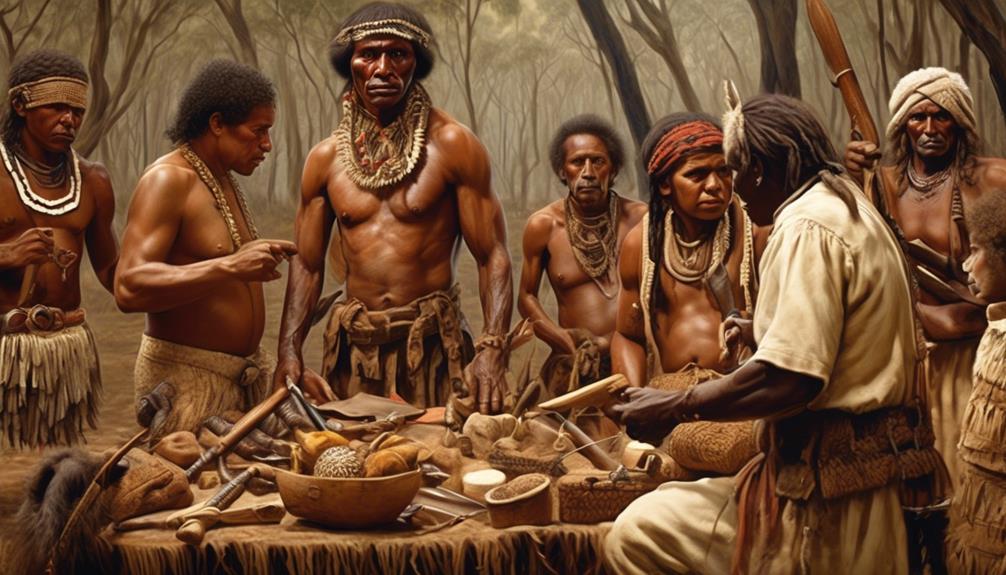
The exchange of goods and knowledge between Aboriginal Australians and British colonizers facilitated a complex process of cultural adaptation and transformation. This cultural exchange led to the adaptation and integration of new technologies, customs, and ideas into the traditional practices of both Aboriginal and British societies. The interactions between the two groups resulted in the sharing of agricultural techniques, food, language, and social customs, leading to a blending of cultures that influenced both parties.
The adaptation process was reciprocal, with both Aboriginal Australians and British colonizers learning from each other. Aboriginal Australians integrated new tools and materials into their daily lives, while British colonizers adopted aspects of Aboriginal culture, such as bush skills and knowledge of the land. This cultural exchange and adaptation allowed for the development of new ways of living and surviving in the challenging Australian environment.
The integration of cultural practices also laid the foundation for mutual understanding and cooperation between the two groups. Through this process, both Aboriginal Australians and British colonizers were able to navigate the complexities of cultural differences and find common ground, ultimately shaping the cultural landscape of Australia.
Long-Term Consequences
As the cultural exchange and adaptation between Aboriginal Australians and British colonizers shaped the early interactions, its long-term consequences continue to influence the contemporary cultural landscape of Australia. The colonial legacy has left a profound impact on the social, economic, and political structures, shaping the dynamics of modern Australian society.
The following are some of the long-term consequences:
- Economic Dependency: The introduction of a market economy by the British colonizers disrupted traditional Aboriginal trading systems, leading to economic dependency on the colonizers and subsequent marginalization of Aboriginal communities.
- Social Inequality: The colonial legacy has entrenched social inequality, with Aboriginal Australians experiencing higher rates of unemployment, lower educational attainment, and poorer health outcomes compared to non-Indigenous Australians.
- Cultural Displacement: The imposition of British cultural norms and values has led to the erosion of traditional Aboriginal customs and languages, contributing to a loss of cultural identity and heritage.
- Land Dispossession: The dispossession of traditional lands and territories has resulted in ongoing land rights struggles and environmental degradation, impacting the spiritual and cultural connection of Aboriginal peoples to their ancestral lands.
- Policy Impacts: Historical colonial policies continue to shape government approaches to Indigenous affairs, influencing contemporary debates on reconciliation, self-determination, and Indigenous rights.
These consequences underscore the enduring impact of the colonial encounter on Aboriginal Australians and highlight the ongoing challenges in addressing historical injustices and building a more equitable future.
Frequently Asked Questions
How Did the Trade Between Aboriginal Australians and British Colonizers Impact the Spiritual Beliefs and Practices of Indigenous Communities?
The trade between Aboriginal Australians and British colonizers deeply impacted the spiritual beliefs and practices of indigenous communities. This cultural exchange influenced our religious practices and trade dynamics.
The introduction of new goods and technologies altered our spiritual rituals and belief systems. The disruption caused by colonization challenged and reshaped our traditions and connection to the land.
The impact on spirituality was profound, forever changing the way we connected with our ancestors and the natural world.
Were There Any Specific Trade Relationships or Partnerships Established Between Certain Aboriginal Groups and British Colonizers?
Trade partnerships between certain Aboriginal groups and British colonizers were established, leading to cultural exchange and cross-cultural interactions.
These interactions had significant economic impacts, shaping social dynamics and environmental consequences.
The trade relationships varied across different Aboriginal communities, influencing their livelihoods and traditions.
It's important to recognize the complexities and nuances of these historical interactions, as they continue to shape the present-day realities of Indigenous communities.
What Were the Long-Term Economic Effects of Trading With British Colonizers on Aboriginal Communities?
Economic impact and cultural exchange between British colonizers and Aboriginal communities were substantial. The long-term effects of trading with British colonizers on Aboriginal communities were enduring.
Economic shifts led to cultural exchange, altering traditional lifestyles. The impact on indigenous economies was immense. The exchange of goods and resources reshaped the economic landscape, setting a path for future challenges and opportunities.
This period of trade had a profound and lasting effect on Aboriginal communities.
Did the Trade With British Colonizers Lead to Any Significant Changes in the Social Hierarchy or Power Structure Within Aboriginal Societies?
In our analysis, the trade with British colonizers did lead to significant changes in the social dynamics and power structures within Aboriginal societies.
The introduction of new goods and technologies altered traditional cultural beliefs and spiritual practices, impacting the existing social hierarchy.
This transformation influenced the distribution of power within Aboriginal communities and had lasting effects on their social organization.
What Was the Environmental Impact of the Trade Between Aboriginal Australians and British Colonizers, Particularly in Terms of Resource Extraction and Land Use?
In terms of resource extraction and land use, the trade between Aboriginal Australians and British colonizers had a significant ecological impact. This had repercussions on our spiritual beliefs, trade relationships, and economic effects.
The changes in land use and resource extraction altered our traditional ways of life, affecting our social hierarchy and power structure.
It's crucial to understand the complex and multifaceted effects of this trade on our environment and society.
Conclusion
In conclusion, the trade between Aboriginal Australians and British colonizers brought about significant cultural exchange and adaptation.
While traditional Indigenous goods like animal hides and tools were exchanged for imported British items such as textiles and metal goods, the long-term consequences of this trade had a profound impact on Aboriginal societies.
It's important to acknowledge the complex dynamics of this historical exchange and its lasting effects on both Indigenous and colonial communities.
